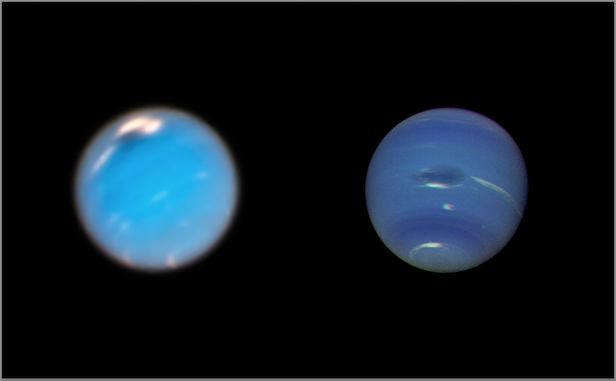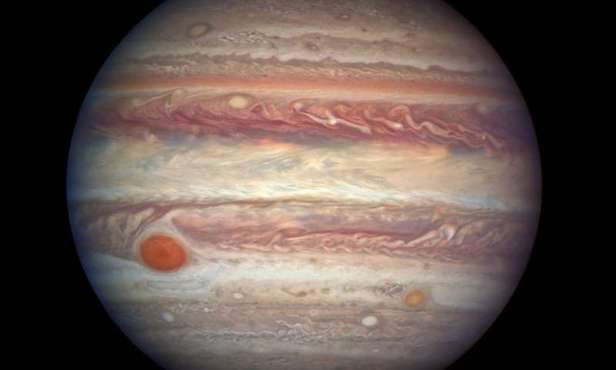Hubble has been watching Neptune’s enormous storm come back into the fold
Comparing the storms on the gas giants Jupiter and Neptune act can tell us interesting details about their formation and evolution

This composite picture shows images of storms on Neptune from the Hubble Space Telescope (left) and the Voyager 2 spacecraft (right). Image credit: NASA/ESA/GSFC/JPL
Images taken by the Hubble Space Telescope document the formation of a Great Dark Spot on Neptune for the first time, report researchers in a new study.
Like Jupiter’s Great Red Spot, Neptune’s Great Dark Spots are storms that form from areas of high atmospheric pressure. In contrast, storms on Earth form around areas of low pressure.
Scientists have seen a total of six dark spots on Neptune over the years. Voyager 2 identified two storms in 1989. Since Hubble was launched in 1990, it has viewed four more of these storms.
In the new study, planetary scientists analysed Hubble’s photos of the ice giant taken over the past several years and chronicled the growth of a new Great Dark Spot that became visible in 2018.
By studying companion clouds that showed up two years before the new Great Dark Spot, the researchers conclude dark spots originate much deeper in Neptune’s atmosphere than previously thought.
The Hubble images also helped the researchers pinpoint how often Neptune gets dark spots and how long they last. The new findings give scientists insights on the inner workings of the poorly-understood ice giant planets but also have implications for studying exoplanets of similar size and composition.
“If you study the exoplanets and you want to understand how they work, you really need to understand our planets first,” says Amy Simon, a planetary scientist at NASA’s Goddard Space Flight Center in Greenbelt, Maryland, United States, and lead author of the new study published today in AGU’s journal Geophysical Research Letters. “We have so little information on Uranus and Neptune.”
Scientists first saw a Great Dark Spot on Neptune in 1989, when NASA’s Voyager 2 probe flew past the mysterious blue planet. As the spacecraft zoomed by, it snapped pictures of two giant storms brewing in Neptune’s southern hemisphere. Scientists dubbed the storms “The Great Dark Spot” and “Dark Spot 2.”
Just five years later, the Hubble Space Telescope took sharp images of Neptune that revealed both the Earth-sized Great Dark Spot and the smaller Dark Spot 2 had vanished.
“It was certainly a surprise,” Simon says. “We were used to looking at Jupiter’s Great Red Spot, which presumably had been there for more than a hundred years.”

Jupiter’s Giant Red Spot has been observed for at least 150 years. Image credit: NASA/ESA/A. Simon
A new Great Dark Spot appeared on Neptune in 2018, nearly identical in size and shape to the one Voyager saw in 1989. Simon and her colleagues were analysing Hubble images of a smaller dark spot that appeared in 2015 when they discovered small, bright white clouds in the region where the 2018 Great Dark Spot would later appear.
“We were so busy tracking this smaller storm from 2015, that we weren’t necessarily expecting to see another big one so soon,” Simon says.
The high-altitude clouds are made up of methane ice crystals, which give them their characteristic bright white colour. Scientists suspect these methane clouds accompany the storms that form dark spots, hovering above them the way lenticular clouds cap tall mountains on Earth.
Simon and co-authors Michael Wong and Andrew Hsu at the University of California Berkeley tracked the methane clouds from 2016 to 2018. They found the clouds were brightest in 2016 and 2017, before the new Great Dark Spot became visible.
Computer models of Neptune’s atmosphere have shown the deeper the storm, the brighter its companion clouds. That these white clouds appeared two years before the Great Dark Spot and that they lost some brightness when it became visible suggests dark spots may originate much deeper in Neptune’s atmosphere than previously thought, according to the new study.
Simon, Wong and Hsu also used images from Hubble and Voyager 2 to pinpoint how long these storms last and how frequently they occur. They report in a second study published today in the Astronomical Journal that they suspect new storms crop up on Neptune every four to six years. Each storm may last up to six years, though two-year lifespans are more likely, according to the findings.
The new findings show how Neptune’s Great Dark Spots differ from Jupiter’s Great Red Spot. The Great Red Spot has been observed since at least 1830 and could be up to 350 years old. Thin jet streams on Jupiter keep the Great Red Spot from breaking apart and from changing latitude; it rotates around Jupiter but doesn’t move north or south.
But Neptunian winds operate in much wider bands around the planet, so storms like the Great Dark Spot slowly drift across latitudes. These storms typically hover between westward equatorial wind jets and eastward-blowing currents in the higher latitudes before strong winds pull them apart.
Planetary scientists hope to next study changes in the shape of the vortex and wind speed in storms that form dark spots. “We have never directly measured winds within Neptune’s dark vortices, but we estimate the wind speeds are in the ballpark of 328 feet (100 metres) per second, quite similar to wind speeds within Jupiter’s Great Red Spot,” says Wong. More frequent observations using Hubble will help paint a clearer picture of how storm systems on Neptune evolve, he said.
Keep up to date with the latest news in All About Space – available every month for just £4.99. Alternatively you can subscribe here for a fraction of the price!




